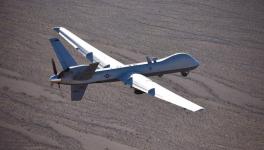India’s MIRV Missile: Deterrence or Higher Risk?

Image Courtesy: X/@DRDO_India
On March 11, 2024 India successfully conducted its first test of a new Agni-V missile with Multiple Independently-targetable Re-entry Vehicle (MIRV) technology, together termed the “Divyastra (celestial weapon) Mission.”
To those unfamiliar with the arcane world and terminology of nuclear weapons and missiles for their delivery, an MIRV missile carries on a single rocket several warheads, each of which can be programmed to travel in different directions at varying speeds to strike at multiple targets several hundreds of kilometres apart. This hugely increases the damage inflicted by a single MIRV missile, and makes it more difficult for adversaries to track and shoot down the warheads.
As expected, there was a loud media chorus of chest-thumping nationalist pride at this display of technological and military prowess. However, as may have happened a decade or more ago, there has been little informed discussion on the costs and benefits of this shift in India’s strategic capability and perhaps also in its nuclear doctrine.
In technology terms, India now joins a handful of countries, namely the US, Russia, the UK, France and China, who have MIRV technology. With this, India has taken a giant leap forward as regards several technologies and systems, such as smaller warheads, advanced sensors and guidance systems, and commensurate programming, tracking and control systems. These represent significant advances with both military and civilian applications.
India is, however, yet to produce and operationally induct MIRV missiles into its nuclear arsenal on different platforms. The other countries named have both land- and submarine-based MIRV missile systems. India faces major challenges in operationalising and deploying MIRV missiles.
In strategic terms, however, the gains are not so obvious. There is good evidence and considerable discussion in strategic circles to suggest that possession of MIRV missiles is a double-edged sword. On the one hand, MIRVs seemingly bestow greater deterrence. On the other hand, they push rivals to adopt more aggressive nuclear postures so as to counter this advantage. MIRVs may, therefore, also drive up the risks of nuclear conflict and increase security threats.
THE TECHNOLOGY
Few details are available in the public domain about the MIRV missile or what the test revealed. However, in the absence of definitive information from DRDO, a broad idea of different aspects may be put together from different sources.
The first thing to note is that we do not know the range of the missile, nor the number of warheads or their weight that the MIRV missile is designed to carry.
The main missile is the Agni-V, the proven latest generation missile in the Agni series. The missile is three-stage. The maiden user trial of the 50-tonne Agni-V with a single 1.5 tonne warhead in operational configuration was conducted in 2021. The Agni-V has since entered service and has been inducted under the Strategic Forces Command.
The missile was believed to have a range of 5,000-5,500 km, just enough to qualify as a long-range Inter-Continental Ballistic Missile (ICBM). However, this has never been confirmed and the Agni-V’s range continues to be classified.
Subsequent information from retired top-ranking DRDO (Defence Research and Development Organisation) scientists associated with the missile development puts the range at closer to 7,000 km, especially after several modifications such as use of composite materials to lower the missile weight and a lower weight warhead.
Researchers in other countries have said DRDO is downplaying the range so as to allay international concerns, and that actual range may even be 8,000 km, sufficient to reach all parts of the neighbourhood.
The MIRV Agni-V is a three-stage missile with a modified nose-cone to accommodate multiple warheads. The missile also carries indigenously developed advanced sensors and guidance systems for greater accuracy of warhead delivery. DRDO scientists have revealed that single-digit accuracy, meaning a strike under less than 10 metres from the designated target point, had been achieved. The test last week was conducted over a range of 3,500 m as per the NOTAM or Notice to Airmen which countries are obliged to issue when conducting a missile test. DRDO is currently compiling the test data from various tracking ships and other stations. It is believed DRDO does not plan to conduct any further tests.
CHALLENGES OF MIRV WEAPONISATION
The Agni-V, which had already transitioned from a rail-launcher to a road-based launcher, now uses a canister-launch system. This gives greater mobility and flexibility, and enables safely storing the missile and warheads for many years inside the canister, which releases the missile through an explosive charge, all steps being completed within a few minutes. This aspect of land-based delivery systems probably requires little or no modification.
However, there is no information yet in the public domain as to whether it is planned to also equip India’s nuclear-capable submarines with MIRV missiles.
It is known that India intends to operationalise the full triad of nuclear platforms i.e., land, air and sea-based. Submarine-based MIRV missiles would pose an even greater threat to adversaries, since they add another layer to the difficulty in tracking and targeting missiles fired from under water.
The range of the MIRVs would be affected by how many warheads are mounted in the MIRV missiles and how much the add-on weight is.
This is related to the extent of miniaturisation of the nuclear warheads. Clearly, some degree of miniaturisation has already been achieved, since a MIRV nose-cone must be able to accommodate several warheads. This has hardly been discussed so far in the MIRV context.
A more problematic issue is the additional fissile material, chiefly plutonium, which would be required for the new MIRV missiles. India is already constrained by a shortage of plutonium from its BARC Dhruva reactor and a small quantity of waste plutonium from its power plants, especially after India placed 14 nuclear reactors using imported fuel out of its total 22 reactors under IAEA (International Atomic Energy Agency) inspection and safeguards as part of the Indo-US nuclear deal.
Decision regarding IAEA safeguards for the four additional sets of approved reactors at Kaiga (Karnataka), Gorakhpur (Haryana), Chutka (MP) and Banswara (Rajasthan) is yet to be taken. This may call for plutonium from India’s Prototype Fast Breeder Reactor near Kalpakkam (Tamil Nadu), where core loading has recently commenced in preparation for commercial operations, only the second in the world after Russia.
DETERRENCE OR HIGHER RISK?
All this sounds good, viewed purely in technological terms as national achievements. But we are talking about nuclear weapons here. The international history of development of nuclear weapons and their delivery systems, right from the first nuclear bomb dropped by the US on Hiroshima thinking it would bring them unchallenged superpower status, teaches us that there is no absolute security guaranteed by possession of nuclear weapons and ever-improving delivery systems.
In the case of MIRVs, some analysts believe it will raise India’s deterrent capability. India already has a no first-use policy, meaning India depends on the threat of inflicting disproportionate damage on an adversary in the event of a pre-emptive strike by the latter. MIRV missiles striking multiple targets simultaneously provide that.
However, other analysts believe that our western neighbour, which depends on a first-strike deterrence to offset its comparative weakness in conventional forces, would now be even more driven towards a pre-emptive strike, especially against MIRV facilities, thus increasing the risk of a nuclear exchange. This is termed the “use it, or lose it” calculus meaning that a country with limited nuclear arsenal, sensing danger of losing even that, would prefer to use it rather than see it destroyed.
In the case of India’s already far more powerful northern neighbour, India’s MIRVs now pose a greater threat than before, driving that neighbour to deploy even greater counter-measures, further increasing threat levels for India. In both cases, security risks increase, not decrease.
The calculus of nuclear deterrence means that every new advance by one power brings a further counter from an adversarial power. Deterrence only keeps shifting to more advanced weapons on all sides, and hence to higher levels of risk, till finally the aptly-named Mutually Assured Destruction or MAD comes into play. That is why global non-proliferation measures have failed so far, in the face of some countries wanting monopoly nuclear weapons status, driving others to also seek possession of this currency of power. The only answer is full global nuclear disarmament.
The writer is with the Delhi Science Forum and All India People’s Science Network. The views are personal.
Get the latest reports & analysis with people's perspective on Protests, movements & deep analytical videos, discussions of the current affairs in your Telegram app. Subscribe to NewsClick's Telegram channel & get Real-Time updates on stories, as they get published on our website.
























